ETC2.0 is a service that utilizes bidirectional communication between roads (roadside units) and vehicles (onboard units) in order to provide a broader scope of information and to better support driving safety than conventional services. Roadside units (RSUs) have been installed at roughly 1,700 locations along expressways and at roughly 1,900 locations along national highways under direct government control throughout Japan. Along expressways, this service provides a broader range of information than before, including dynamic route guidance corresponding to road conditions at the time, images of upcoming areas with obstacles, and information to support driving safety where accidents frequently occur.
In addition, vehicles equipped with ETC2.0 service compliant onboard units (OBUs) accumulate a “travel history” and “behavior history” in a privacy-protected format. This information, which is widely used by road traffic authorities, is collected as probe data when these vehicles pass under an RSU. (Probe data is only collected with the consent of the user)
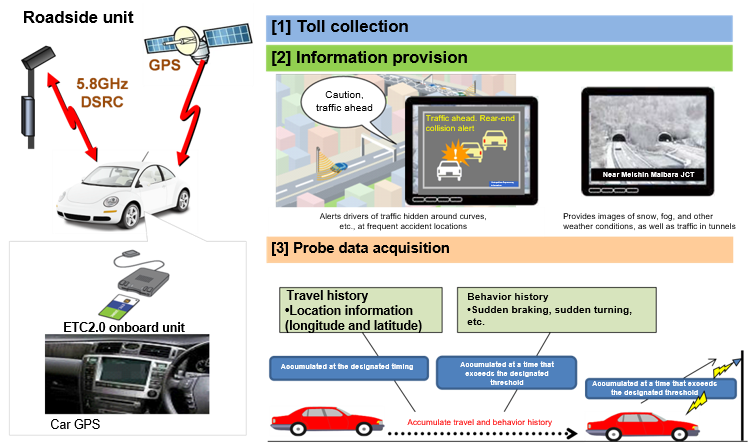 ETC2.0 Overview
ETC2.0 Overview
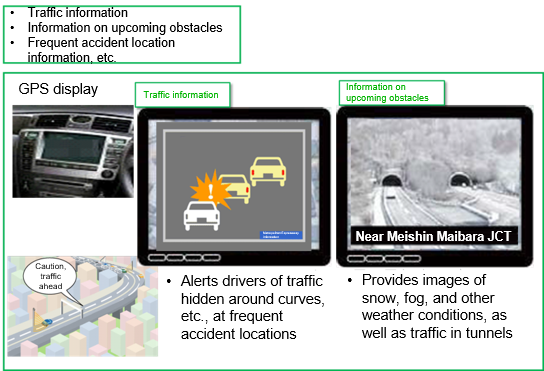 Details of Information Provided by ETC2.0 [1]
Details of Information Provided by ETC2.0 [1]
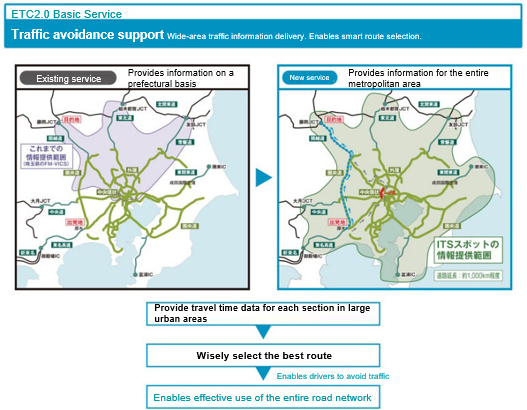 Details of Information Provided by ETC2.0 [2]
Details of Information Provided by ETC2.0 [2]
Probe data collected from vehicles equipped with an ETC2.0 OBU is aggregated and processed to enable their use in road surveys, research, and management.
Collecting and analyzing travel history data helps identify the travel speeds along each road section on different days and times. These data can be used to identify sections where traffic congestion frequently occurs and to plan traffic facilitation measures.
Collecting and analyzing behavior history data helps identify where sudden braking (rapid deceleration) frequently occurs. These data can be used to identify near-miss incident locations and to plan traffic safety measures.
In addition, when a service provider managing vehicles equipped with ETC2.0 OBUs requests, probe data that specifies the information for the ID of the OBU (specific probe data) can also be extracted and used to track vehicles. Specific probe data is also used for the “Oversized/Overweight Vehicle Gold System” which simplifies oversized/overweight vehicle travel permitting.
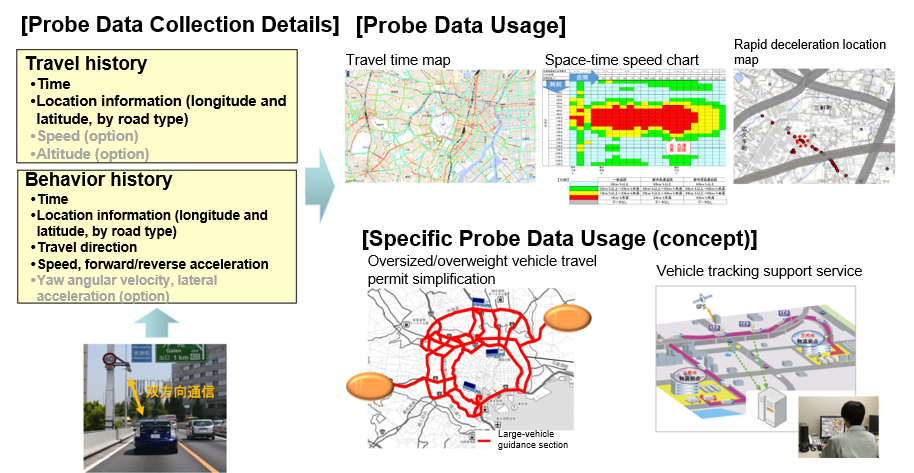 Probe Data Overview and Usage Concept
Probe Data Overview and Usage Concept
In addition, probe data are also used for measures such as discounting expressway tolls for vehicles equipped with ETC2.0 OBUs when using beltways (KEN-O EXPRESSWAY) to detour around urban areas. These data are also used for “Smart Fares” which allow vehicles to temporarily exit expressways in sections where the interval between expressway rest facilities is long.
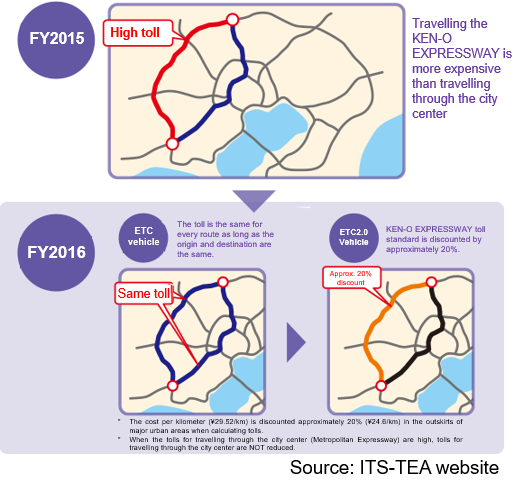 ETC2.0 Toll Discount
ETC2.0 Toll Discount
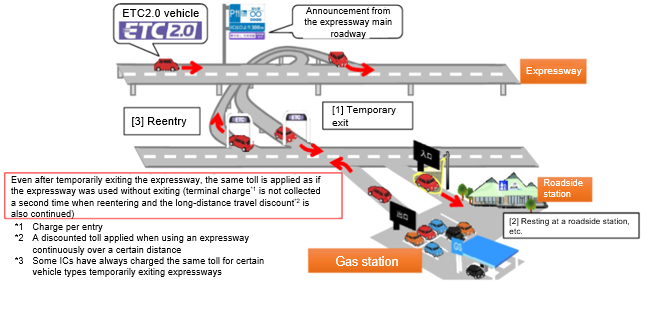 Temporarily exit the expressway
Temporarily exit the expressway
In order to realize safer and more efficient transportation, logistics companies require the ability to identify the current location of their vehicles and the status (safety, etc.) of their drivers. Although there are services that identify these conditions in real-time using online digital tachographs and drive recorders, they incur certain costs, such as equipment purchases, installation fees, communications fees, and service usage fees.
Starting in FY2015, the Ministry of Land, Infrastructure, Transport and Tourism (MLIT) conducted and verified the results of a real-world experiment (19 participants) in which data, such as the transit information and travel history that can be obtained when a vehicle equipped with an ETC2.0 OBU passes an ETC2.0 RSU installed on an expressway or public road, were used for vehicle tracking and other services.
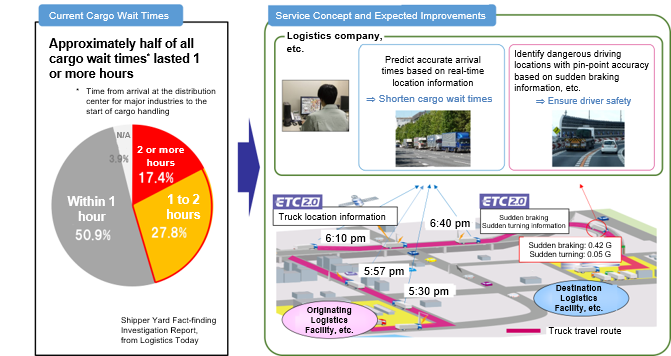 Figure 1 ETC2.0 Vehicle Tracking Support Service Concept
Figure 1 ETC2.0 Vehicle Tracking Support Service Concept
Of the 19 participants who used the ETC2.0 probe data-based vehicle location display service, 17 rated the service as useful. They did so in part because it enabled them to respond rapidly by confirming vehicle locations and because it reduced wait times for drivers and cargo handlers. On the other hand, participants also pointed out an issue in that there is a time lag in obtaining information about sections where no RSUs are installed due to the delay in data collection in these sections.
This service was also rated as useful because six out of the seven drivers who used the service for displaying the locations where sudden braking frequently occurs were able to identify these locations to improve their awareness of driving safety and reduce the number of sudden braking events.
Although ETC2.0 probe data-based vehicle tracking is limited in terms of real-time data collection because data are only collected when a vehicle passes under an RSU, the system is advantageous in that there are no communications costs and in that it is easy to use because the only device required for the vehicle is an ETC2.0 OBU. These advantages were another reason the system received positive ratings from participants.
Following verification through real-world testing, we have begun full-scale introduction of the “ETC2.0 Vehicle Tracking Support Service,” which provides travel locations, sudden braking events, and other data for vehicles equipped with ETC2.0. For details, please visit the website of the service provider selected via public offering (Highway Industry Development Organization)
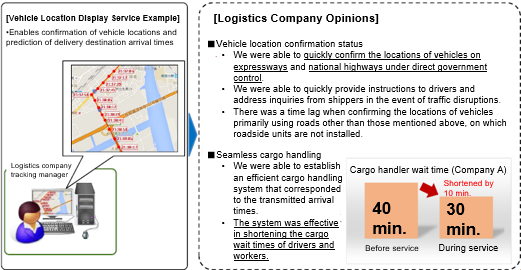 Figure 2 Vehicle Location Display Service Concept and Evaluation
Figure 2 Vehicle Location Display Service Concept and Evaluation
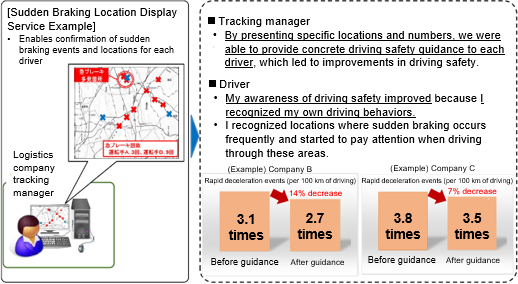 Figure 3 Frequent Sudden Braking Location Display Service Concept and Evaluation
Figure 3 Frequent Sudden Braking Location Display Service Concept and Evaluation
MLIT widely uses ETC2.0 probe data to make analyses in the field of road traffic, including analyzing traffic congestion and identifying travel performance in the event of disasters.
When the vehicle is in motion the ETC2.0 OBU internal memory stores the ETC2.0 probe data, which are collected later on when the vehicle passes an ETC2.0 probe data collection roadside unit (hereinafter, “RSU”). However, OBUs have limited memory (approximately 80 km of travel history and 31 behavior history events), so old probe data are overwritten by new data when the memory limit is exceeded. Existing RSUs are also only installed along expressways and national roads under direct government control. This makes collecting probe data difficult in areas far from existing RSUs or over route sections that do not use national roads.
In order to efficiently collect ETC2.0 probe data from such areas, the National Institute for Land and Infrastructure Management (NILIM) developed a portable ETC2.0 probe data collection roadside unit (hereinafter, “portable RSU”).
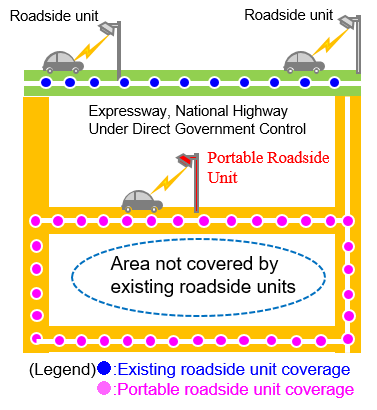 Result of Installing Portable Roadside Units
Result of Installing Portable Roadside Units
Portable RSUs are intended for flexible installation wherever necessary, so they are designed under the assumption that the dedicated optical network operated by MLIT does not exist in the vicinity of the target location. These units thus have a wireless unit that communicates with the control unit at each Regional Development Bureau via a telecommunications service provider’s lines. ETC2.0 probe data collected by the control units are sent to a processing server in the same way as with existing RSUs. The integrated server run by the Kanto Regional Development Bureau then aggregates and processes these data.
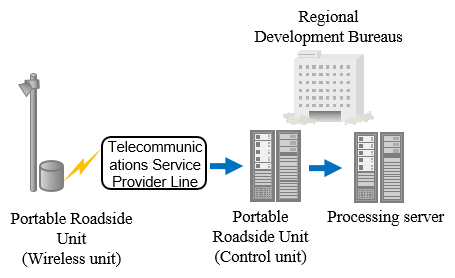 Portable Roadside Unit Layout
Portable Roadside Unit Layout
Currently, NILIM has installed portable RSUs to collect ETC2.0 probe data on a trial basis. With the cooperation of the Chugoku Regional Development Bureau and local governments in Hiroshima and Okayama Prefectures, NILIM installed portable RSUs at event venues, tourist sites, and other locations in each region for around one week to collect data. As an example, portable RSUs were installed in the vicinity of Kurashiki Bikan Historical Quarter, a tourist site in Okayama prefecture (Installation period: 1 week from Friday, November 22 to Thursday, November 28, 2019; Number of portable roadside units: 4).
In order to verify the effectiveness of portable RSUs for identifying the characteristics of visitors using vehicles and for analyzing traffic patterns in the vicinity of this tourist site, a total of four portable RSUs were installed for this trial. One unit was installed in each of the four large parking lots around the Kurashiki Bikan Historical Quarter to enable the collection of more ETC2.0 probe data over a wide area. Despite differences among the installation sites, the trial still successfully collected ETC2.0 probe data from several hundred to around 1,000 vehicles per installation site during the one-week period.
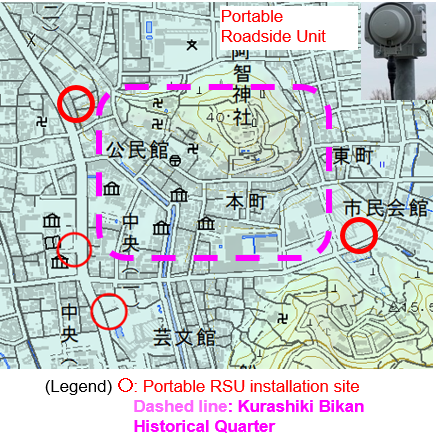 ETC2.0 Probe Data Coverage Using Portable Roadside Units in the Kurashiki Bikan Historical Quarter
ETC2.0 Probe Data Coverage Using Portable Roadside Units in the Kurashiki Bikan Historical Quarter
In the future, we will compare and verify the amount of information when portable RSUs are and are not installed, as well as conduct traffic analyses, route analyses, and other analyses in the field of road traffic, based on the ETC2.0 probe data collected from portable RSUs. These analyses will serve to evaluate the impact and effectiveness of portable RSU installations. At the same time, assuming that road administrators, including national and local public authorities, will use portable RSUs to resolve regional traffic problems and such, we plan to compile a collection of portable RSU application examples and prepare a manual that summarizes the installation methods and points to consider during operation.